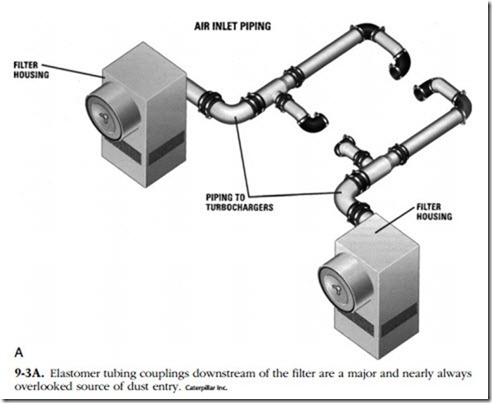Most diesels have open manifolds without the restriction imposed by a throttle plate. As a result, these engines ingest about 2.5 ft3 of air per horsepower. Much of the air merely cycles through the engine without taking part in combustion. But atmospheric air, even at its most pristine, contains mineral dust and other solids that, unless removed, result in rapid upper cylinder wear. Research has shown that the most destructive particulates in the air-inlet system are between 10 and 20 µm in diame- ter. A micron is one millionth of a meter or 4/100,000 in.
The ideal air cleaner would trap all solids, regardless of size. Unfortunately, such a device does not exist, at least in practical form. Some particulates get through, which is why engines tend to wear rapidly in dusty environments, no matter how carefully maintained.
Construction
Older engines are often fitted with oil-bath filters that combine oil-wetted filtration with inertial separation (Fig. 9-1). Air enters at the top of the unit through the precleaner, or cyclone. Internal vanes cause the air stream to rotate, which tends to separate out the larger and heavier particulates. The air then passes through the central tube to the bottom of the canister, where it reverses direction. Some fraction of the remaining particulates fail to make the U-turn and end in the oil reservoir. Most of those that remain are trapped in the oiled mesh.
These devices depend, in great part, upon the velocity of the incoming air to centrifuge out heavier particles. At low engine speeds, the particles remain in the air stream, and filtration depends solely upon the oil-wetted mesh. Under ideal circumstances filtering efficiency is no more than 95% and, in practice, can be much less.
If overfilled, subjected to high flow-rates, or tilted much off the horizontal, oil-bath cleaners bleed oil into the intake manifold. The oil can plug the aftercooler and raise exhaust temperatures enough to cause early turbocharger failure.
Figure 9-2 shows a replaceable paper-element filter of the type used on automo- biles and light trucks. When used for industrial engines, the paper element is often combined with a prefilter and a centrifugal precleaner. At their most sophisticated, paper-element filters can have an efficiency of 99.99%. Efficiency improves when the filter is lightly impacted with dust. Engines operated in extremely dusty environments also benefit from an exhaust-powered ejector mounted upstream of the filter.
The filter should be mounted horizontally on the manifold to reduce the possibil- ity of dirt entry when the element is changed. Filters that mount vertically, such as the one shown in Fig. 9-2, should include a semi-permanent safety element below the main filter. This element functions to trap dust when the filter is removed for servicing.
All engines should have some sort of filter monitoring device that, if not sup- plied by the manufacturer, can be fabricated by the simple expedient of plumbing a
vacuum gauge immediately downstream of the filter. When new, paper-element fil- ters impose a pressure drop of about 6.0 in./H2O and the inlet ducting usually adds about 3.0 in./H2O. Engine performance falls off noticeably when the total system pressure drop exceeds 15 in./H2O.
Service the filter only when the air-restriction indicator trips, since each time the element is removed some dust enters the system. Before removing the element wipe off all dust from the inside of the filter housing. Do not blow out paper elements with compressed air: a tear in the element, so small that it may not be visible to the eye, exposes the engine to massive amounts of dust intrusion.
And before we leave the subject, it should be remarked that “high-performance” filters can provide marginal power increases by reducing pumping losses. But the reduction in pressure drop often comes at the cost of reduced filtration efficiency. Any air filter worthy of its name should have its efficiency certified by a third party under the protocols of the SAE air cleaner test code J726.
Rebuilt engines almost always have shorter lives than new engines. For years it was believed that factory inspection and assembly procedures gave new engines the edge. But evidence is accumulating that abrasives entering from leaks in the flexible tubing couplings downstream of the filter are the culprit (Fig. 9-3a). These couplings, which see boost temperatures of 300°–400°F (149°–204°C), harden with age and are rarely replaced. Nor is it possible to detect leaks by external inspection of the tubing and hose couplings. However, the presence of leaks will be revealed by streaks in the dust film that collects on inlet-tubing inner diameters (IDs). The origin of the streak marks the point of dirt entry.
Flexible couplings should be replaced periodically and as inexpensive insurance for rebuilt engines. Secure the coupling with SAE type F clamps—not worm-gear plumber’s clamps—that provide a 360° seal.


